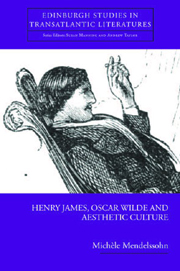Book contents
- Frontmatter
- Contents
- Acknowledgements
- List of Abbreviations
- List of Figures
- Dedication
- Introduction
- 1 ‘I Have Asked Henry James Not to Bring his Friend Oscar Wilde’: Daisy Miller, Washington Square and The Politics of Transatlantic Aestheticism
- 2 The Gentle Art of Making Enemies and of Remaking Aestheticism
- 3 The School of the Future as well as the Present: Wilde's Impressions of James in Intentions and The Picture of Dorian Gray
- 4 ‘Wild Thoughts and Desire! Things I Can't Tell You – Words I Can't Speak!’: The Drama of Identity in The Importance of Being Earnest and Guy Domville
- 5 Despoiling Poynton: James, the Wilde Trials and Interior Decoration
- 6 ‘A Nest of Almost Infant Blackmailers’: The End of Innocence in The Turn of the Screw and De Profundis
- Bibliography
- Index
3 - The School of the Future as well as the Present: Wilde's Impressions of James in Intentions and The Picture of Dorian Gray
Published online by Cambridge University Press: 12 September 2012
- Frontmatter
- Contents
- Acknowledgements
- List of Abbreviations
- List of Figures
- Dedication
- Introduction
- 1 ‘I Have Asked Henry James Not to Bring his Friend Oscar Wilde’: Daisy Miller, Washington Square and The Politics of Transatlantic Aestheticism
- 2 The Gentle Art of Making Enemies and of Remaking Aestheticism
- 3 The School of the Future as well as the Present: Wilde's Impressions of James in Intentions and The Picture of Dorian Gray
- 4 ‘Wild Thoughts and Desire! Things I Can't Tell You – Words I Can't Speak!’: The Drama of Identity in The Importance of Being Earnest and Guy Domville
- 5 Despoiling Poynton: James, the Wilde Trials and Interior Decoration
- 6 ‘A Nest of Almost Infant Blackmailers’: The End of Innocence in The Turn of the Screw and De Profundis
- Bibliography
- Index
Summary
As we saw in Chapter 1, James's 1882 visit to the United States had been marked by the death of his mother. A year later, James was called back to wintry Cambridge, Massachusetts to bury his father. After the funeral, he stayed on as his father's executor and tried to keep busy. In the spring of 1883, he went to Washington, where he had met Wilde the year before. He visited Henry and Marian Adams again, but this time there was no worry, as there had been on James's previous visit, that he would ‘bring his friend Oscar Wilde’ since Wilde had by then taken up residence in Paris.
From Washington, James wrote to the publisher James R. Osgood to describe his latest projects, many of which involved impressionism. There was a collection of travel writings he proposed to call ‘Impressions of Art and Life’ or ‘Superficial Impressions’, and a short story titled ‘The Impressions of a Cousin’. James's return to Washington brought still a third item to mind, ‘an episode in the lives of a group of contemporary “aesthetes”, the former American, the other “international” ’ (L2 414). He detailed the prospective story as:
the history of an American aesthete (or possibly an English one), who conceives a violent admiration for a French aesthete (a contemporary novelist), and goes to Paris to make his acquaintance; where he finds that his Frenchman is so much more thoroughgoing a specimen of the day than himself, that he is appalled and returns to Philistinism. Or else (I haven’t settled it) he is to discover that the Frenchman who is so Swinburnian in his writings, is a regular quiet bourgeois in his life; which operates upon the aesthete as a terrible disillusionment. I may add that there will be a woman in the case. The idea of the thing is to show a contrast between the modern aesthete, who poses for artistic feelings, but is very hollow, and the real artist – who is immensely different’. (emphasis added)
- Type
- Chapter
- Information
- Henry James Oscar Wilde and Aesthetic Culture , pp. 127 - 162Publisher: Edinburgh University PressPrint publication year: 2007



